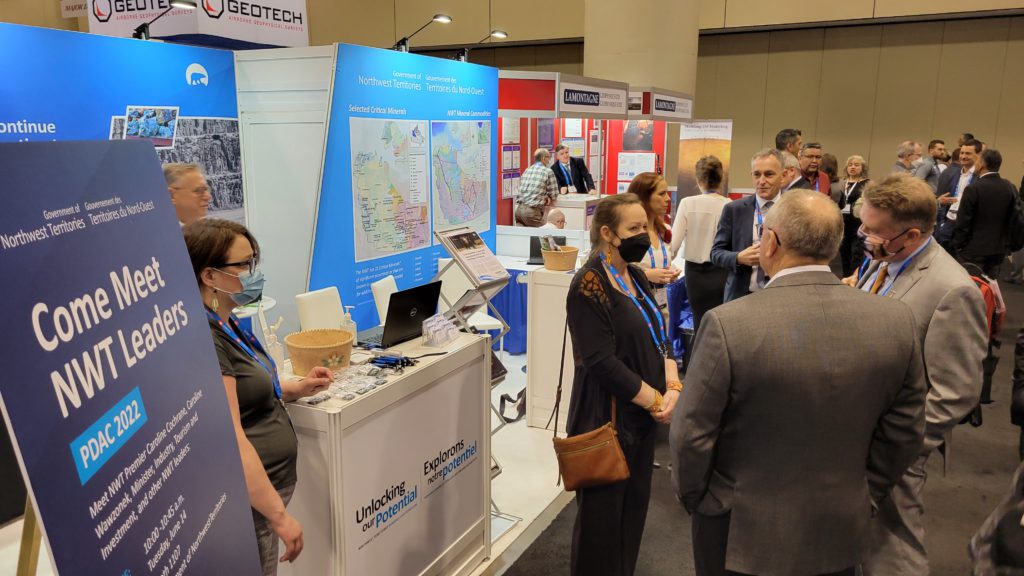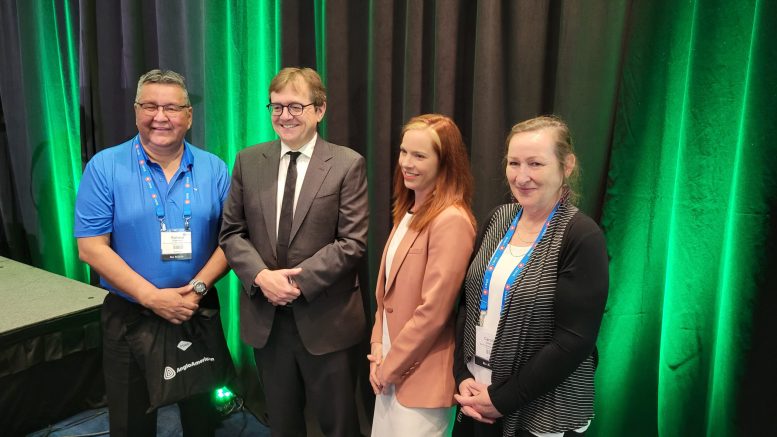In the Northwest Territories, infrastructure that lags behind southern Canada is limiting the potential of the territory’s mining development and increasing its costs as well, said leaders of the N.W.T. government at the Prospectors and Developers Association of Canada (PDAC) conference in Toronto on June 14.
Premier Caroline Cochrane and Minister of Industry, Tourism and Investment Caroline Wawzonek told The Northern Miner in an interview that they want the federal government to step up and provide more support for the territory’s infrastructure needs.
While mining has historically been the economic bedrock of the N.W.T. and currently accounts for 21% of its GDP, just about half of its 33 communities are connected to all-season roads. This reality affects economic and social development.

Premier Caroline Cochrane and Industry, Tourism and Investment Minister Caroline Wawzonek, along with Indigenous leadership from the NWT and the city of Yellowknife met with industry leaders on June 14 on the PDAC trade show floor. Credit: NWT Government
“Things that people in the south take for granted — people can jump in the car and drive from one city to another city in a matter of hours — in the Northwest Territories we don’t have that luxury,” said Cochrane.
“That infrastructure is important so that people can access jobs. If people have to jump on an airplane, pay $1,000 just to get one way, how are they going to afford the price of milk and bread?”
Cochrane added that an inadequate broadband internet network across the vast territory and a limited power grid that makes many communities reliant on diesel generators also hold back access to economic opportunities.
When it comes to mining, those limitations make mines more costly, and miners are forced to pursue “only the most viable” projects, said Wawzonek.
“There’s potential for so much more in the resource sector in the North, if the cost of developing the projects isn’t as high because we have more of that basic infrastructure in the first place. I think the federal government has a role there,” she said.
Turning to the issue of the $3.8 billion the federal government earmarked in the latest budget for its Critical Minerals strategy, Wawzonek said it was exciting and has come up in many discussions at PDAC, with people asking ‘what’s next?’
“[That] lies with the federal government. I’m told that they will be working with provinces and territories one at a time to develop how these funds will roll out. But exactly how it’s going to roll out, to whom, to where, and when — those details aren’t worked out yet,” the Industry minister said.
Included in the allocation is $1.5 billion over seven years to develop infrastructure for critical mineral supply chains.
That is particularly interesting for the N.W.T. after the Nechalacho mine southeast of Yellowknife shipped out its first load of mixed rare earths concentrate in April, becoming Canada’s first rare earths producer.
Australia’s Vital Metals (ASX: VML; US-OTC: VTMXF), which owns Nechalacho acquired the near-surface resources at the site from Avalon Advanced Materials (TSX: AVL; US-OTC: AVLNF) in 2019. Avalon retains ownership of the mineral resources below a depth of 150 metres above sea level. Vital has land use and water licence permits to mine the currently producing North T Zone at the project.
Nechalacho is part of a supply chain where the concentrate will be processed at a facility in Saskatchewan and then shipped to Norway, where rare earths producer REEtec will refine it into oxides. That company has secured an agreement with German auto parts supplier Schaeffler, who will purchase the oxides.

An aerial view of the Nechalacho rare earths mine pit in Canada’s Northwest Territories. Credit: Vital Metals
That is another area where Ottawa could bring a national vision to bolster such supply chains with geopolitical significance, Wawzonek said.
“What if we were to actually bring second stage processing in Quebec? I know they have processing facilities. What if, instead of using them for electric vehicles in Europe, they were being shipped to the manufacturers in southern Ontario? If we can really start to think strategically, then that supply chain can be in Canada,” she said.
The senior leaders also want a Northern-focused tax credit to come out of the Critical Minerals Strategy and the critical minerals exploration tax credit mentioned in the budget.
That tax credit would benefit exploration and mining in the North, where costs are higher than in southern Canada.
“Projects could also be incentivized,” Wawzonek said. “Say, you can go and invest in a project that’s in Ontario with decent rock or you can come invest in a project that has outstanding rock in the North, but just costs a little bit more. It can start to equalize what’s happening on the cost front.”
With 2022 now half over, the Northern leaders hope that the N.W.T. receives high priority by the federal government when it rolls out the critical minerals money before the year is done.
“I think they’re calling them ‘energy resource regional tables.’ I would like to sit down and have the Northwest Territories energy and resource table,” Wawzonek said. “That will help figure out how they are intending to spend these billions of dollars. [I hope] that is early enough that if there’s going to be any particular projects that need things coming up on the winter road… that they can catch the 2023 construction season.”


Be the first to comment on "PDAC 2022: NWT leaders ask Ottawa to help with infrastructure to benefit mining"